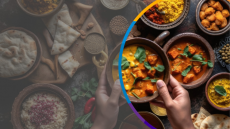New hydrocolloid more viscous than guar gum: study
hydrocolloid from the leaves of Corchorus olitorius has
found it to have even better viscosity than guar hum and locust
bean gum, adding to evidence of its food industry potential.
Also known as jute, Corchorus olitorius is a plant native to Egypt and the Middle and Near East. Its stem is rich in fibre and its leaves in vitamin B and beta carotene, meaning it has been consumed as a nutritious food in some parts of the world. The team investigated the stand-alone characteristics and rheological properties of the new hydrocolloid, which was obtained by modified ammonium sulfate fractionation (VHLC). The viscoelastic properties were measured using low-amplitude oscillatory measurements, and the team reported that the hydrocolloid exhibited "gel-like character" at the concentration of higher than 0.5 per cent (w/w). "Viscosity of the hydrocolloids surpassed other food hydrocolloids such as guar gum and locust bean gum at the same condition (0.25 to around 1.0 per cent (w/w), 25ºC". They also noted that when the hydrocolloid was heated over 60 ºC (to around 100ºC), an irreversible increase in viscosity was seen. This, they said, suggests a conformational change of the polysaccharide molecule. In their conclusion the researchers wrote: "It is well acknowledged that high viscosity of food hydrocolloid is one of the most important requests for food industry, and, therefore, VHLC could be an interesting and promising thickener." Further study should be conducted to fully understand its potential, they said. In fact, the same team has previously reported on the potential of a hydrocolloid from Corchorus olitorius for use in food. Last year the journal Food Hydrocolloids published a study in which strong synergistic effects between the Corchorus olitorius hydrocolloid (HLC) and established hydrocolloid kappa-carrageenan were observed. They reported that the synergistic effect on mixed gel made with kappa-carrageenan was different from mixed gels with locust bean gum. In the case of addition of HLC, the maximum synergistic effect was observed at the sugar composition (kappa-carrageenan/HLC) of 90/10 while that of kappa-carrageenan/LBG were observed around 60/40 to 50/50. "The difference implies that HLC could not only be an alternative to LBG in many applications, but may introduce new functions to kappa-carrageenan and other hydrocolloids," they said. Sources: Food Hydrocolloids (Elseveier) Published online ahead of print Doi: 10.1016/j.foodhyd.2008.03.012 Title: "High viscosity of hydrocoloid from leaves of Corchorus olitorius L" Authors: Eiji Yamazaki, Osamu Kurita, Yasuki Matsumura Doi: 10.1016/j.foodhyd.2007.03.009 "Hydrocolloid from leaves of Corchorus olitorius and its synergistic effect on kappa-carrageenan gel strength" Authors: E. Yamazaki, O. Kurita, Y. Matsumura




















